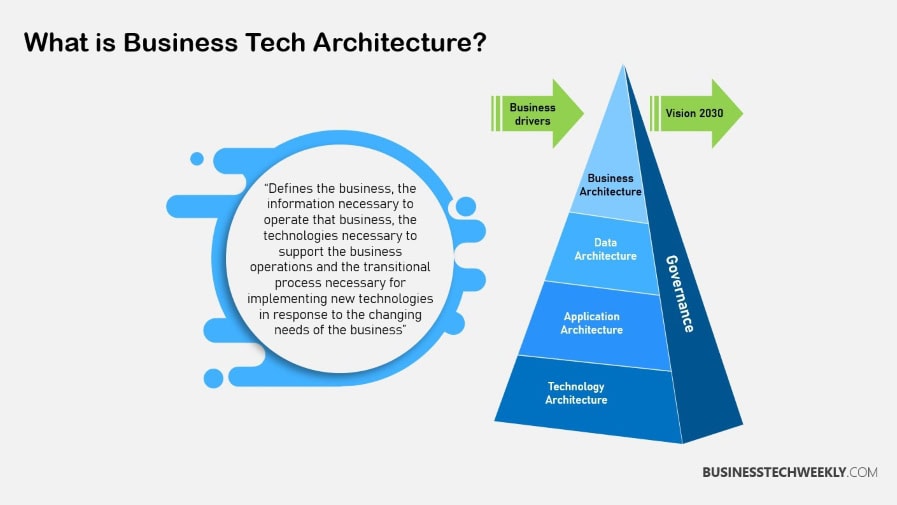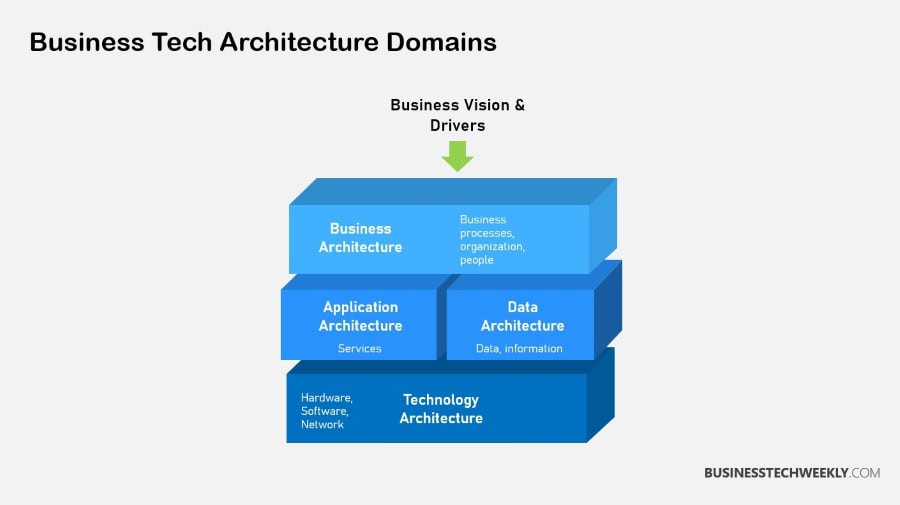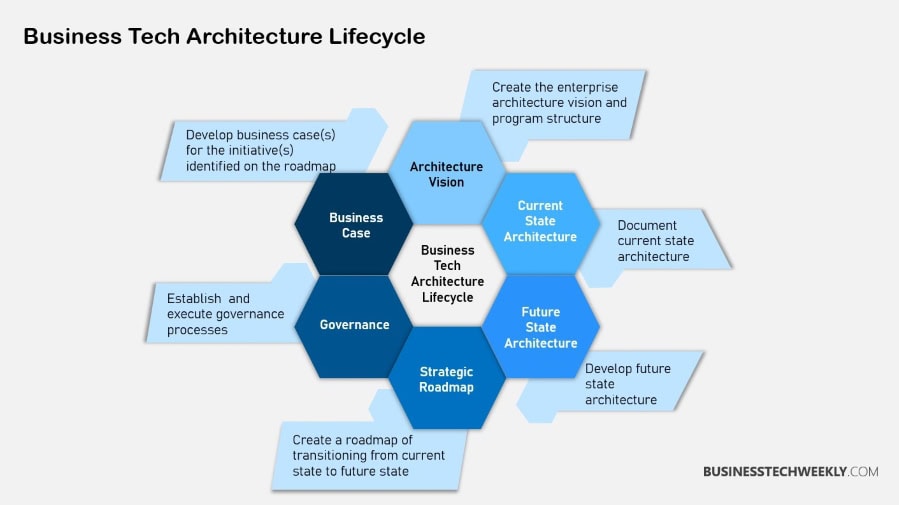Business Tech Architecture: Definition & Key Components

On this page:
What is Business Tech Architecture
Definition of Business Tech Architecture
Business tech architecture provides a language and framework to intentionally connect technology with desired business outcomes.
It’s a combination of business architecture practices and technology infrastructure components.
This added framework goes a long way in establishing a safe space for the tech and business sides to work together.
In unifying the technology components, it uplifts and protects the larger enterprise architecture, preventing components from running grassroots initiatives that can collide or operate in silos.
Business architecture, a core component of this, helps to define the soul of the organization.
It delivers a cross-organizational design tightly connected to enterprise architecture. Its development from the 1980s onward is a testament to its critical role in shaping business tactics and operations.

Key Components of Business Tech Architecture
Business tech architecture, like business architecture, consists of business models, business capabilities, business processes, and business information systems.
Together, these components work in tandem to improve organizational effectiveness.
Here’s a simple breakdown:
|
Component |
Role & Contribution |
|---|---|
|
Business Models |
Define how the business operates and creates value |
|
Capabilities |
Outline what the business can do |
|
Processes |
Describe the flow of business operations |
|
Information Systems |
Support data management and decision-making |
Business architecture helps produce a richer, more connected view of an organization in concert with enterprise architecture.
It focuses on business strategy, business capabilities, and more.
With 70% of organizations using business architecture, the benefits are clear: effective strategies, boosted efficiency, and clearer communication.
Importance in Organizational Strategy
Business tech architecture provides a roadmap that aligns technology initiatives directly with business objectives.
This alignment helps to guarantee that each and every technology investment and project is directly helping to further your organization’s goals.
For example, if your organization’s mission is to provide better customer service, the blueprint can help focus resources on technologies that support better customer engagement.
This alignment of effort is critical to ensuring resources are focused in the most efficient manner possible, producing the best possible outcomes.
RELATED: Getting started with Hybrid Cloud Architectures
A strong enterprise business technology architecture simplifies and improves overall operations by connecting duplicated and redundant processes across business units.
By integrating these efforts, you remove redundancies and other inefficiencies, making your organization more agile and responsive.
For instance, by ensuring access to shared data is available in a consistent manner across departments, you can avoid redundant work and improve efficiency.
Second, strong business technology architecture doubles profitability.
Through the standardization and management it brings, it cuts costs by aligning IT with business goals.
Companies that have strong architectural strategies in place tend to experience significantly better returns on their technology investments.

Enhancing Operational Efficiency
Business tech architecture creates a blueprint for building efficient workflows.
Breaking down these silos increases teamwork and cross-departmental communication.
It frees teams to be informed and collaborate cohesively.
Like Walmart, architects have long helped companies use architecture to make their companies run better and be more efficient.
Supporting Strategic Decision-Making
Business tech architecture gives you a critical, comprehensive data set to make thoughtful decisions.
It helps align technology investments with strategic priorities, making sure resources are focused on the most effective actions.
Business architects enable strategic planning and execution by developing deliverables essential to informed decision-making.
RELATED: Unlocking the Power of Multi Cloud Architecture
Facilitating Innovation and Growth
A strong business tech architecture incubates innovation by giving new initiatives a solid base to build from.
At its core, it allows technology to fuel innovation and entrepreneurship — the sort of innovation and entrepreneurship that built companies like Google.
Radical breakthroughs frequently come from disciplined design, laying the groundwork for long-term impact and prosperity.
Best Practices for Implementation
Here are three essential steps to implementing business tech architecture successfully.
Begin with a clear idea of your current technology landscape.
Evaluating what’s already in place allows your team to see what’s missing and where there’s room for improvement. Understanding these will help you tackle them head on with a smart, flexible tech architecture plan.
1. Assess Current Infrastructure
Take stock of what your current tech infrastructure looks like. This helps to spot gaps and areas where the architecture can make a difference.
Like any effort to change policy or practice, knowing what capabilities already exist is key.
For example, if you’re migrating to a cloud service provider such as AWS, use their architectural best practice frameworks to ensure you’re aligned.
2. Align with Business Goals
Aligning technology initiatives with business strategies makes sure that your architecture is focused on supporting high-level objectives.
Reference a checklist to make sure this alignment happens.
Business architects play a vital role in bridging the gap between tech and leadership, ensuring both parties work towards common goals.
RELATED: Designing Business Intelligence Architecture
3. Prioritize Security and Compliance
Security is the bedrock of any tech architecture.
Build in security features and follow compliance standards to protect your information.
Think about building security practices into your entire ecosystem to shield private data.
4. Foster Collaboration Across Teams
Working together is critical to building smart and effective tech architecture.
Implement tools and practices that encourage collaboration between all stakeholders.
When you take a collaborative approach, everyone’s perspective is taken into account, resulting in a much better outcome.
5. Monitor and Optimize Continuously
Install a regular architecture review process.
Establish metrics and KPIs to compare against performance.
API observability and monitoring helps you focus initiatives and management costs, so your architecture can change as your requirements do.

Challenges in Business Tech Architecture
The reality of implementing a business architecture framework usually means tackling some tough challenges.
To achieve collaboration, many organizations struggle to navigate the challenge of juggling numerous technology systems, which creates a lack of efficiency and drives higher expenditures. The complexity of these systems necessitates detailed coordination to ensure they all mesh perfectly.
Simplifying these complex architectures can be achieved through a variety of best practices, including ensuring designs are modular and leveraging middleware solutions that improve usability and efficiency.
Tools like enterprise architecture software can help visualize system interactions, aiding in smoother management of the enterprise architecture components.
The second challenge is finding the right balance between cost and value.
So it’s way past time to start looking at the cost-effectiveness of tech investments. Projects should be ranked according to their highest return-on-investment.
Frameworks such as cost-benefit analysis assist in understanding the potential financial benefits, informing choices that serve the organization’s interests.
RELATED: Creating a Network Security Strategy: Best Practices for Protecting Your Business
Scalability and flexibility should be equally prioritized in the architecture governance process.
A scalable architecture can handle growth easily without massive changes.
Solutions that offer flexibility, like cloud-based options, can grow with business needs.
Examples include e-commerce platforms that scale during peak shopping seasons, maintaining performance without additional infrastructure.
Cultural resistance to change is a big obstacle. Without buy-in from employees, new systems will face resistance and struggle with adoption.
Addressing this challenge demands strategic outreach, transparent messaging, and dedicated resources.
By engaging stakeholders and clearly showcasing the value of the business architecture, you can build a bridge between business and IT.

Emerging Trends in Tech Architecture
The state of the business technology architecture, driven by the cloud revolution and artificial intelligence, is emerging as a popular enterprise architecture framework.
These trends are seriously changing how organizations think about their business architecture and tech investments, enabling companies to implement business architecture effectively and stay ahead in an increasingly rapid environment.
Adoption of Cloud Solutions
They provide the flexibility, scalability, and cost efficiency that’s only possible with cloud-based solutions.
As organizations migrate workloads to the cloud, they must adopt a holistic security and compliance strategy.
Companies such as Netflix and Amazon have made the leap to microservices frameworks and increased their efficiency in the process.
In 2023, serverless computing, hybrid clouds, and edge computing will become more sophisticated, opening up new avenues for innovation.
Integration of AI and Machine Learning
AI and machine learning can fundamentally change how we process information and make decisions.
By bringing together these technologies, organizations can accelerate innovation and achieve better outcomes.
Hyperautomation continues to grow, with semi-autonomous systems making their mark.
Organizations that learn to use AI to their benefit will be able to accelerate their organizational goals and lead the industry.
Emphasis on Data-Driven Strategies
Data analytics will play a significant role in the emerging tech architecture.
From optimizing routes to anticipate demand, data-driven strategies can increase efficiency while maximizing customer satisfaction.
To truly become data-centric, organizations need to invest in strong analytics capabilities.
With RPA success stories across data-reliant industries like healthcare, the value of data-driven strategies cannot be overstated.

Key Points to Consider
Business tech architecture influences the fate of firms. It provides a strong foundation for economic development and job creation.
Embrace best practices to build a strong tech foundation.
- Business tech architecture is key to making sure technology serves business objectives. It improves efficiency and effectiveness of operations and provides an overall structure for the organization’s activities.
- Knowing the essential building blocks like business architecture, business processes, business information architecture this knowledge is essential in keeping businesses efficient and supporting their strategic alignment.
- With smart business tech architecture in place, businesses can better optimize their operations, eliminate unnecessary redundancies, and profit as a result.
- A strong tech architecture promotes innovation and economic growth by encouraging the type of environment that allows businesses to use technology to adapt and thrive.
- Successful implementation depends on best practices such as stakeholder engagement, continuous evaluation, and ensuring alignment with business goals.
- Coordinating multiple complex systems, balancing cost and value, and providing scalability are critically important. Such challenges are most important for creating a flexible, resilient, and adaptable architecture framework.

